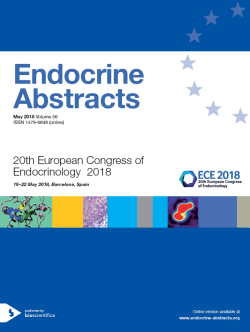
20th European Congress of Endocrinology
Barcelona,
Spain
19 May 2018 - 22 May 2018
Oral Communications
The curious case of growth hormone
ea0056oc13.1 | The curious case of growth hormone | ECE2018
Postoperative use of somatostatin analogs and mortality in patients with acromegaly
Postma Mark R , Wolters Thalijn LC , van den Berg Gerrit , van Herwaarden Antonius E , Kobold Anneke C Muller , Sluiter Wim J , Wagenmakers Margreet A , van den Bergh Alfons CM , Wolffenbuttel Bruce HR , Hermus Ad RMM , Netea-Maier Romana T , van Beek Andre P
ea0056oc13.2 | The curious case of growth hormone | ECE2018
Time trends of mortality in patients with GH secreting and non-functioning pituitary adenoma
Galoiu Simona , Silea Simona , Baciu Ionela , Trifanescu Raluca Alexandra , Niculescu Dan , Capatina Cristina , Radian Serban , Dumitrascu Anda , Caragheorgheopol Andra , Poiana Catalina
ea0056oc13.3 | The curious case of growth hormone | ECE2018
Molecular profiling for assistance to pharmacological treatment of acromegaly
Puig-Domingo Manuel , Gil Joan , Sampedro Miguel , Webb Susan M , Serra Guillermo , Salinas Isabel , Blanco Alberto , Marques-Pamies Montse , Pico Antonio , Garcia-Martinez Araceli , Blanco Concepcion , Del Pozo Carlos , Obiols Gabriel , Alvarez-Escola Cristina , Camara Rosa , Fajardo Carmen , Luque Raul , Castano Justo , Robledo Mercedes , Jorda Mireia , Bernabeu Ignacio , Marazuela Monica
ea0056oc13.4 | The curious case of growth hormone | ECE2018
Effects of pegvisomant on glucose metabolism in acromegaly: A meta-analysis of prospective interventional studies
Feola Tiziana , Cozzolino Alessia , Puliani Giulia , Sbardella Emilia , Gianfrilli Daniele , Hasenmajer Valeria , Simonelli Ilaria , Pasqualetti Patrizio , Lenzi Andrea , Isidori Andrea M.
ea0056oc13.5 | The curious case of growth hormone | ECE2018
Growth hormone acts in AgRP neurons to control energy expenditure during food restriction and promotes counter-regulatory responses to hypoglycemia via the ventromedial hypothalamus
Furigo Isadora C , Teixeira Pryscila DS , Souza Gabriel O , List Eduard , Kopchick John , Donato Jose



